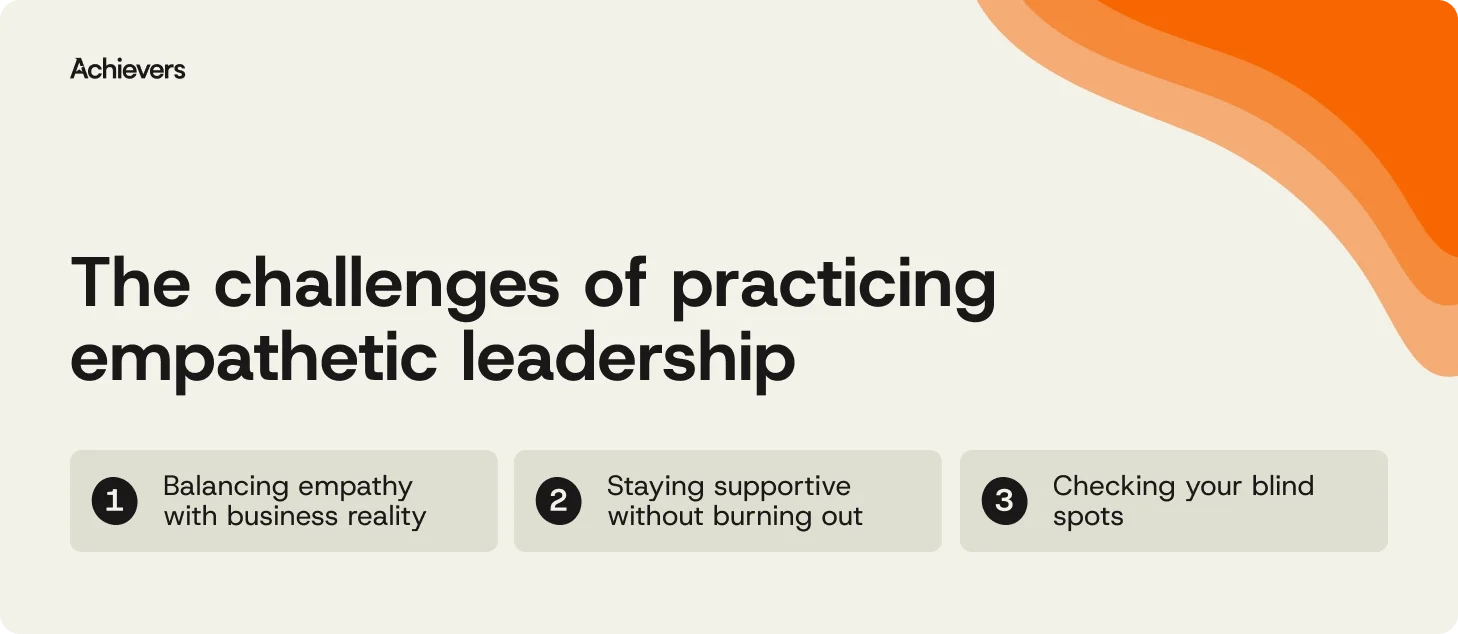Table of contents
Empathy in leadership isn’t new — but it’s never been more essential. As employee expectations evolve, today’s workforce is looking for more than direction. They want leaders who get it: the pressure, the pace, the need for balance. Leaders who listen, support growth, and foster trust in a way that feels human — shaping an organizational culture where people feel genuinely seen and supported.
And when they do? The impact is tangible. Empathetic leaders help drive stronger engagement, lower turnover, and higher-performing teams. In fact, 86% of employees say empathy boosts morale, and 87% call it critical to creating an inclusive workplace. Empathy isn’t just good leadership — it’s good business.
So, let’s dive deeper into why empathy matters in leadership — and explore practical ways leaders can develop this crucial skill.
Empathetic leadership, explained
Empathetic leadership is less about handholding and more about human understanding. It’s the ability to recognize what employees are going through — and respond in ways that support both their well-being and the company’s goals. Rooted in emotional intelligence, it means tuning in, not checking out. Empathetic leaders listen actively, care openly, and know that when people feel supported, performance follows. It’s not about trading results for feelings — it’s about realizing they’re more connected than we often admit.
What empathetic leadership makes possible
Empathy isn’t fluff — it’s a force multiplier. When leaders lead with empathy, it doesn’t just make people feel good (though it does that too). It drives real results by building a workplace where employees feel seen, supported, and motivated to bring their best.
And if you’re looking for proof, we’ve got the numbers — straight from Achievers Workforce Institute (AWI):
Higher engagement and motivation
When people feel genuinely appreciated, they’re more likely to stay connected to their work — and give it their all. Empathy creates the kind of environment where employees know their contributions matter, which leads to higher performance, greater employee satisfaction, and fewer “just-getting-through-the-day” Mondays.
AWI stats to back this up
- Employees who feel recognized are 1.8x more likely to strongly agree they are productive at work, and 1.6x more likely to say they consistently perform at their best.
- 91% say they’d put in more effort if they felt valued at work.
Lower turnover and burnout
Empathetic leadership makes it harder for people to slip through the cracks. Leaders who recognize effort and offer support build trust — the kind that keeps people committed and less likely to burn out or check out.
AWI stats to back this up
- 44% of employees who feel recognized say they can see themselves having a long career with their company, compared to just 26% who disagree or strongly disagree.
- Employees who receive weekly recognition are 2.1x more likely to report engagement and alignment with company values.
Stronger collaboration and trust
Empathy makes room for honesty. When leaders prioritize psychological safety and open communication, teams respond with better ideas, tighter collaboration, and a willingness to have each other’s backs — even on deadline day.
AWI stats to back this up
- Employees who feel meaningfully recognized are 1.9x more likely to report a strong sense of belonging.
- Recognition from managers makes employees 1.6x more likely to feel engaged, productive, and supported — all key ingredients for collaborative, high-trust teams.
Better mental health and well-being
Empathetic leaders don’t just notice when someone’s off — they act on it. A little check-in goes a long way in reducing stress and helping employees feel grounded. It’s better for well-being, better for employee morale, and better for business in the long run.
AWI stats to back this up
- Employees who feel meaningfully recognized are 1.8x more likely to say they can handle unexpected challenges — a sign of improved resilience and psychological safety.
- 92% of recognized employees say they feel informed during times of organizational uncertainty.
Becoming the leader people actually want
Empathy doesn’t come with a job title — it comes with practice. Developing empathetic leadership takes intention, a bit of self-reflection, and a genuine interest in the people you lead. The good news? Small, consistent actions make a big difference. Here’s where to start:
- Listen like you mean it: Real empathy starts with real listening. That means putting down the phone, making eye contact (yes, even on Zoom), and asking open questions that invite honest answers. Validate what you hear — even if you can’t fix everything — because sometimes being heard is half the solution.
- Lead with a little humanity: Perfection is overrated. Sharing your own missteps and challenges helps build connection and trust. Vulnerability isn’t weakness — it’s a shortcut to stronger relationships and a more authentic leadership style.
- Make one-on-ones matter: Skip the status updates and use regular check-ins and 360-degree feedback to get to know what really drives your people. What’s going well? What’s keeping them up at night? These conversations are your best opportunity to show employees they’re more than a to-do list.
- Create space for honesty: Empathetic leaders don’t just welcome feedback — they make it safe to give. When employees know they won’t be judged or sidelined for speaking up, they’re far more likely to share the ideas, concerns, or insights that could move the team forward.
- Recognize early, often, and well: Nothing says “I see you” like meaningful recognition. Use a platform like Achievers to celebrate the small wins, the big efforts, and everything in between. It’s not about gold stars — it’s about reinforcing the behaviors and values that shape a thriving culture.
Leading with empathy (when it’s not so easy)
Empathy is powerful — but let’s be honest, it’s not always easy. Leading with heart doesn’t mean leaving your head at the door. Like any skill worth having, empathetic leadership comes with its own learning curve. Here are a few common challenges (and how to tackle them):

- Balancing empathy with business reality: Caring about people doesn’t mean avoiding tough calls. Great leaders know how to listen and support their teams — while still keeping the business on track. Empathy isn’t about saying yes to everything; it’s about making thoughtful decisions that take both people and performance into account.
- Staying supportive without burning out: Empathy requires emotional energy, and that energy has limits. Without boundaries, leaders can end up stretched thin — or unintentionally playing favorites. The key is consistency. Show up for everyone, not just the people you relate to most, and make sure you’re recharging, too. (Pro tip: empathy works better when you’re not burnt out and running on fumes.)
- Checking your blind spots: Even the most well-meaning leaders have biases — because, well, we’re human. Practicing empathy means being open to learning, asking for feedback, and doing the work to understand perspectives that aren’t your own. It’s not about having all the answers — it’s about being willing to listen and grow.
Empathy, backed by Achievers
Empathy isn’t just about good intentions — it’s about consistent actions. That’s where Achievers comes in. We give leaders the tools they need to connect with their people in meaningful ways, helping build a culture where employees feel heard, valued, and yes, genuinely appreciated.
- Recognition that actually means something: Our platform makes it easy for leaders to recognize employees frequently and personally — no generic “great job!” messages here. Recognition tied to real behaviors not only boosts morale, it reinforces what matters most. The result? Stronger relationships, more motivation, and a culture where people feel a sense of belonging.
- Feedback that fuels better leadership: With real-time feedback and sentiment tools, leaders can stay in tune with how employees are really doing — not just what shows up in the quarterly survey. Spot issues early, respond with empathy, and build trust by showing you’re actually listening (and acting on it).
The payoff speaks for itself. Organizations using Achievers to prioritize recognition and feedback see measurable gains in engagement, retention, and employee satisfaction. Because when leaders lead with empathy — and back it up with the right tools — everyone wins.
Empathy isn’t optional — it’s the future of leadership
Let’s be honest: the old command-and-control style of leadership hasn’t aged well. Today’s workforce expects more — more humanity, more understanding, more connection. And empathetic leadership delivers. It strengthens culture, boosts engagement, and builds teams that actually want to stick around and do their best work.
As the world of work keeps shifting, empathy will set great leaders apart. It attracts top talent, fosters trust, and helps teams weather change without losing momentum. Leaders who practice empathy — and back it up with the right tools — are better equipped to support their people and drive real, lasting results.
The takeaway? Empathy isn’t a trend. It’s a strategy. And it’s one that pays off. With the right mindset and the right support, you can shape a workplace where people feel seen, supported, and ready to thrive.
Ready to make empathy part of your leadership DNA? We’re here to help.



